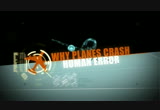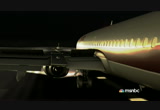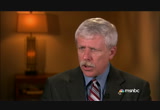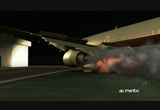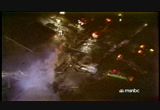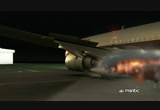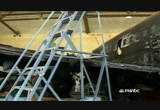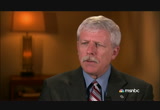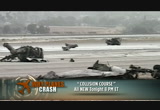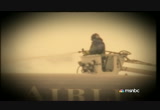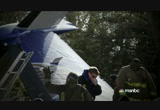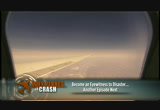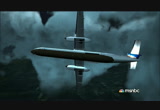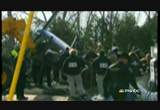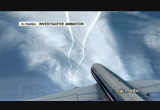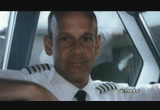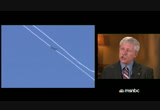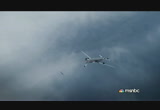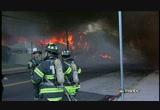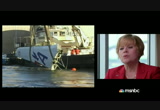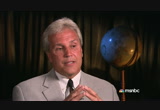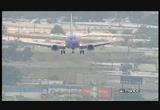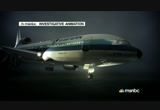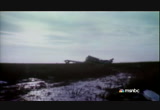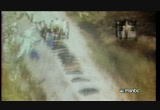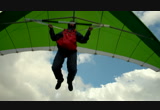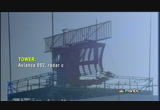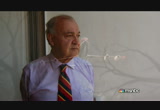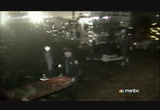tv Why Planes Crash Human Error MSNBC April 27, 2013 4:00pm-5:01pm PDT
4:00 pm
a 737 crashes. >> it was as if we were in the middle of a fireball. >> two months after 9/11, an airbus crashes. its tail mysteriously breaking off. >> how much blood has to be spilled before we take corrective action. >> an l-1011 jumbo jet loses altitude and plunges into the everglades. what triggers the disaster? >> every bit of my clothing was blown right off. >> just miles from a runway, a jet runs out of fuel and slams into a hillside. >> it doesn't take an aeronautics expert to know that
4:01 pm
if your engines go off, it's difficult to fly. >> and a routine continental commuter flight pitches and nosedives into a crowded buffalo suburb. >> it was like a bomb. >> mistakes, oversights, distractions, and in some cases poor judgment, all these crashes are caused by human error. >> the devastation to the entire operation is catastrophic. it's one of your own has potentially made an error that has resulted in this calamity, this tragedy. ♪ there are many reasons why planes crash. poor weather conditions, mechanical difficulties and structural failures. but according to a study by the
4:02 pm
faa, more often than not the cause is just plain human error. >> human error shows up in about 80% of aviation accidents. if you find something that is mechanical on an airplane, you can change it. changing how humans think or how they react under a given set of circumstances is much, much more difficult. >> in this hour, dramatic animations that will put you where no camera has ever been. up close to show how and why these disasters occur. it appears to be a normal landing as u.s. air flight 1493 lowers its main landing gears on to the runway at los angeles international airport. and then in a flash -- >> what the hell? >> the 737 smashes on to a commuter turbo prop that is sitting on the same runway, crushing the smaller plane
4:03 pm
completely. >> the window next to me started melting. >> in the early evening of february 1, 1991, sky west flight 5569, a turbo prop carrying ten passengers and two crew members taxis towards an intersection of runway 24 left. >> intersection departures, particularly for a turboprop was a means to make their flight more effective. and they could get off the ground faster. >> at 6:04 p.m., an air traffic controller clears sky west on to the runway but advises the plane to hold its position. >> at that point is where one of the big causes of this accident sequence occur. she does not immediately clear them for take-off. there is a delay. every second that goes by there is a mounting threat. >> that's because minutes
4:04 pm
earlier usair flight 1493, a 737 that began its journey in syracuse, new york, had been cleared to land on that same runway. >> all they see is the menagerie of lights. in their mental picture, it looks like a normal landing runway. as they are flying closer and closer they still can't discern airplane lights from runway lights. they are all the same color. >> the boeing 737s main landing gear touches down. then as the nose lowers the landing lights reveal the turboprop. that's the first time the captain sees the plane. >> what the hell. >> there is an explosion on impact and the small plane bursts into flames but the 737 can't stop. at 70 miles an hour it skids and finally crashes into an abandoned fire house. >> the floor was heaving. and it -- smoke burst right in
4:05 pm
front of my jump suit. >> it was as if we were in the middle of the big fire ball. every passenger window was illuminated orange. >> i could see every passenger that could possibly have a view of me staring at me looking for an answer. >> flight attendants start shouting orders to evacuate but because of the raging fire, none of the left exit doors can be used. the front right exit door is damaged and won't stay open. only a few are able to escape from there. >> we jumped off the aircraft. i pushed the first person out of the aircraft because i figure it's either you break your leg or you will not see your legs. >> the right wing exit becomes blocked leaving only one more exit for passengers to escape. the right rear exit. in all 67 of the 89 passengers and crew make it out alive. but not everyone makes it through the exit doors. >> we took a position on the nose of the airplane and we
4:06 pm
happened to see that the co-pilot of the plane was trying to get out of the window. i took the ladder, a small 12-foot ladder and put it up to the nose of the airplane. and i was able to take a few steps up and pull him out and cradle him like a baby and bring him down and walk him with another fireman to safety. >> the captain and senior flight attendant are among the victims. >> i remember feeling just a lot of sorrow. two of my crew members died. so many passengers died. >> with the focus on the 737, few even know there is a crushed turbo prop underneath it. the small plane is twisted and mangled beyond recognition. there are no survivors. >> i did not know that we hit another aircraft until we were in the terminal and they were doing triage on us and i asked about the crew and they said which crew? >> coming up trying to figure out exactly what happened.
4:07 pm
4:08 pm
i did? when visa signature asked everybody what upgraded experiences really mattered... you suggested luxury car service instead of "strength training with patrick willis." come on todd! flap them chicken wings. [ grunts ] well, i travel a lot and umm... [ male announcer ] at visa signature, every upgraded experience comes from listening to our cardholders. visa signature. your idea of what a card should be.
4:10 pm
when usair flight 1493 crashes into sky west 5569, the aftermath is horrific. 22 people on the usair flight including the captain are killed. all ten passengers and two crew members in the small sky west plane also die. >> i wouldn't expect that the -- anyone on the sky west to have ever understood what happened. it was instantaneous. >> investigators immediately begin the grim task of finding out what went wrong. john cox who is now an msnbc aviation analyst, was an investigator for the airline pilots association at the time. >> as an investigator it is one of the tougher ones i had worked. because there were still some of
4:11 pm
the bodies were still in there. these things are always catastrophic to work. it is absolutely vital that a group of people do this job so that we understand what happened and don't have a reoccurrence. >> while poor visibility from the tower to the runway and glare shining into the tower are part of the problem, investigators focus on air traffic control. >> air traffic controllers, as a matter of routine multitask. they are issuing landing clearances, take-off clearances, so the multitasking on that evening would not have been unusual. it is very unusual for a controller not to remember that they have an airplane in position on a runway. >> but according to the ntsb that is exactly what happened. it turns out that the local controller simply forgot that skywest was sitting on the runway intersection. >> there were some things that
4:12 pm
were going on that did get her distracted. 1493 checked in. she looked. the runway end was clear. and it was just a human error. >> at the ntsb hearings, the air traffic controller, robin was r washer, testifies that she initially thought it was an act of terrorism. >> 1493 came over the threshold. when the aircraft blew up, i assumed it was a bomb. that the aircraft had a bomb on board then it blew up. >> then washer remembers another plane was on the runway. >> i went to the ground control, and i said see if you're in contact with sky west 569. i went to the supervisor and i told her, i said i believe this is what usair hit. >> she has a responsibility to ensure its safety from other traffic. that didn't happen. >> the sound was almost overwhelming.
4:13 pm
>> david kelly, the surviving first officer, testifies that he and the captain were never made aware of another plane on the runway. >> as far as we could tell there was nothing down the runway anywhere. that airplane all of a sudden showed up out of nowhere. >> cabin lights went out, emergency lights came on. >> for flight attendant bill ibara, who was critically injured, the hearing is an emotional experience. >> i was filled with gratitude when passengers who survived came over and thanked me for my actions. >> as a consequence of the collision, intersection departures at night are no longer permitted. while on the runway, pilots are encouraged though not required to remind air traffic control that they are waiting for instructions. >> these types of procedures were completely capable of being
4:14 pm
done before the accident. this was a totally preventable accident. >> across the country and nearly two decades later, another crash caused by human error. continental connection flight 3407 nears the buffalo airport for landing. the turbo prop suddenly pitches up, stalls, and goes into a series of terrifying rolls. the pilot fights to gain control, but the plane plummets 1,600 feet into a house. >> the aircraft was five miles out and all of the sudden we have no response from that aircraft. >> february 12, 2009, winter storms delay flight 3407 for two hours at newark international
4:15 pm
airport in new jersey. once it departs the flight takes only an hour to buffalo. but three miles from the runway, the captain runs into problems. >> the speed was a little higher than he anticipated and he made an adjustment. what he did was reduced the power and extended the landing gear which adds a lot of drag. the speed decreased fairly rapidly to the point that a warning device this the airplane activated -- >> the warning system seems to take the captain by surprise. it should be a fairly simple correction to get the plane's speed back up. >> instead of letting the airplane's nose drop to build up the air speed, he gave it full power. he lifted the nose up. he should have done the exact opposite thing. >> planes generally fly at a slight nose up angle. this makes air move faster over the top of the wing than bottom this creates the important difference in pressure needed for lift which allows planes to fly. with too much pitch the air pushes against the wing not
4:16 pm
flowing across it, causing the plane to stall. >> when it stalled, the airplane became unstable. it rolled off to one side then another. he continued to have the nose up. >> the plane's stall protection system tries to take over by lowering the nose to gain air speed. but the captain repeatedly pulls the nose back up, essentially putting the plane back into a stall. after three stalls, recovery is impossible. the plane crashes five miles northeast of the buffalo airport. everyone on board is killed as well as one man on the ground. one of the victims is the daughter of a former continental pilot mike loftus. >> marilyn was going up to a reunion game. basically it was an alumni game for the buffalo state college for a women's game. i think i turned on the tv that
4:17 pm
night to watch her for a brief moment. that is when i saw the flames and i had to turn the tv off. >> coming up, inexperience spells disaster for a pilot who misreads his plane and his situation. is the better choice for him, he's agreed to give it up. that's today? [ male announcer ] we'll be with him all day as he goes back to taking tylenol. i was okay, but after lunch my knee started to hurt again. and now i've got to take more pills. ♪ yup. another pill stop. can i get my aleve back yet? ♪ for my pain, i want my aleve. ♪ [ male announcer ] look for the easy-open red arthritis cap. it's delicious. so now we've turned her toffee into a business. my goal was to take an idea and make it happen. i'm janet long and i formed my toffee company through legalzoom. i never really thought i would make money doing what i love. [ robert ] we created legalzoom to help people start their business and launch their dreams.
4:18 pm
go to legalzoom.com today and make your business dream a reality. at legalzoom.com we put the law on your side. humans. even when we cross our t's and dot our i's, we still run into problems. namely, other humans. which is why at liberty mutual insurance, auto policies come with new car replacement and accident forgiveness if you qualify.
4:19 pm
see what else comes standard at libertymutual.com. liberty mutual insurance. responsibility. what's your policy? [ beeping ] ♪ [ male announcer ] we don't just certify our pre-owned vehicles. we inspect, analyze and recondition each one, until it's nothing short of a genuine certified pre-owned... mercedes-benz for the next new owner. ♪ hurry in to your authorized mercedes-benz dealer for 1.99% financing during our certified pre-owned sales event through april 30th.
4:20 pm
when continental connection flight 3407 crashes into a buffalo suburb on a wintry february night in 2009, there are no survivors. the tragedy raises many questions. >> the air speed decreased and after further pitch and roll excursions, the airplane pitched down and entered a steep decent from which it did not recover. >> one question is why the captain responded incorrectly when the plane stalled. according to the ntsb, part of the problem may have been the pilot's basic skills. the report states that the captain never revealed to colgan, the regional carrier for flight 3407, that he had failed several certification exams. >> he apparently wasn't completely honest in reporting those. but while he was at colgan, he
4:21 pm
had also not passed some of the tests and the checks that he had had. >> captain renslo eventually passes all of the required tests. colgan points out that their training meets or exceeds requirements of the faa. but former inspector general of the department of transportation mary sciavo points to what she sees as the problem with the regional airlines in general, cost cutting. >> their whole business model is to fly inexpensive aircraft and save a lot of money. because they have a fixed-price contract. so they can fly cheap planes, cheaply. they make money on their contract. if they have more expensive pilots, more expensive planes they don't. >> the regional airlines association disputes that and told nbc news that their focus is on safety, professionalism and reliability of service.
4:22 pm
still, there are differences within the industry on how much flying time is required to pilot a commercial airplane. >> you can be done with those ratings in as little as 350 hours of experience. what happens is when people get out of flight school, and they have their required government ratings, they then move on to the regionals because that is who hires them. >> while major airlines pay better they usually demand that new hires have 1500 flight hours or more. further blame could lie with how colgan trained its pilots on the q400 stall protection system. although it satisfied faa standards, some of the training was done solely in a classroom setting, not hands on. >> 15 minutes is all they are asking out of the training program. they didn't even do that. they talked about it in ground school. the alarms is going off, the stick is pulled out of your
4:23 pm
hands, the natural reaction is to take and yank it back. the natural action is what he did. he has never been trained. >> the ntsb report also focuses on crew fatigue. both the captain and co-pilot spent the night not in a hotel or in their own beds, but instead in a crew lounge, against colgan policy. once behind the controls they violated the sterile cockpit rule which may have been the cause of their distraction. >> during takeoffs and approach to landings, the pilot and co-pilot can talk about nothing but the flight at hand. >> the idle conversation that was going on seems to have distracted them long enough for the aircraft to get to that point where it was a jarring moment that caused them to react. >> the crash sparked enough debate that in the summer of 2010 the president signs a bill passed by congress requiring commercial pilots have a minimum
4:24 pm
of 1,500 hours of flying time. >> beyond that, there are a score of other safety provisions. they would require the faa to get much more tough on pilot fatigue. they would require that the airlines disclose who is actually operating their flights so that no longer could people buy a ticket on colgan without knowing. so this legislation is very significant. >> the companies let them down a lot. they didn't give them the tools they needed is what it came down to. you had two relatively inexperienced pilots. it's a fact of life. eight years earlier there was another air disaster over new york also caused by human error. an airbus a-300 takes off from jfk airport to santo domingo in the dominican republic. soon after take off the plane encounters turbulence. it rolls, pitches, and suddenly the tail snaps off. the plane nose dives into a
4:25 pm
residential area in queens new york. >> all the people on that airplane went for a harrowing ride in the last minute of flight going into the ground. >> all 260 people on board are killed as well as five people on the ground, leaving investigators wondering how and why the tail would snap off an airplane. november 12, 2001, it is a bright sunny fall morning as american airlines flight 587 climbs into the sky. in the cockpit are two experienced pilots. co-pilot stan molen and captain ed states. >> he loved to get in the airplane. he loved to be in charge and respected everybody's job, everybody's role. >> the co-pilot is flying the plane and is about five miles behind a 747 on its way to japan.
4:26 pm
>> we're climbing to 5,000. >> since the airbus is climbing faster than the plane in front of it, flight 587 quickly fli flies into the 747s wake, causing the american airlines plane to experience turbulence. this is not uncommon. >> airplane wakes are common to the wakes made by boats or ships. it is a displacement as the vehicle passes through this fluid. in one case water. in one case air. >> this faa simulation illustrates a different jet flying into wake turbulence. the wing tips from the lead plane create what is known as a wake vortex. >> you can think of it as a very large cone coming back off the tip of the leading airplane. if the trailing airplane intercepts that cone you will feel choppiness. typically the encounters are very brief but you can hit them multiple times. >> that is exactly what happens
4:27 pm
with flight 587. there are two wake encounters. although invisible to the human eye they are displayed here in our animation. the first wake causes the plane to roll to the left and the co-pilot quickly puts it back on course. but then 15 seconds later, the plane is caught in a second wake. >> when this pilot got into the wake turbulence, the airplane started to roll. he put in flight control corrections that he thought was necessary to get the airplane back to a wings-level state. >> but instead of leveling out, the plane moves violently on all three axes of flight, left and right rolls, side to side motion, and up and down. then the unthinkable happens. the tail snaps off. the plane banks left and plummets into a residential neighborhood in bell harbor queens. just two minutes and 24 seconds
4:28 pm
after a routine take off, everybody on flight 587 is gone. >> we saw a huge -- tremendous amount of black smoke south of long island. >> captain ed state's wife mary is home when she finds out about a crash in long island and contacts american airlines. >> i got one of the chief pilots in new york. and it wasn't the -- wasn't the ideal way of telling me, but i said was ed the pilot and they said yes. >> a devastating loss of life. a horrible scene in a residential neighborhood. >> looks like a war zone. you seen anything on television. it's just -- terrible. >> just two months after 9/11, people were wondering could this be another terrorist attack? >> everyone should remain calm. we talked to the white house several times. there is air cover. >> in this anxious climate the
4:29 pm
ntsb works to find the reason the tail of the plane broke off. coming up, outrage over the official cause of the crash of american airlines flight 587. wait for it... wait for it... ah! ah! wait for it... wait for it... [ laughs ] you know, i'm not trying to be ungrateful here or anything... but i just don't think i should have to wait for it! who do you think i am, quicken loans? ♪ at quicken loans, we won't make you wait for it. our efficient, online system allows us to get you through your home loan process fast. which means you'll never have to beg for a quick closing. in fact, here at quicken loans
4:30 pm
we close the majority of our home loans in thirty days or less... and that's pretty darn fast! because we believe you've got better things to do than to wait for months for your loan to close. super fast closings... one more way quicken loans is engineered to amaze. ♪ [ dogs barking ] bikes and balloons, wholesome noodles on spoons. a kite, a breeze, a dunk of grilled cheese. catches and throws, and spaghettio's. that's what happy kids are made of. campbell's. it's amazing what soup can do.
4:32 pm
a mississippi man has been arrested and charged with sending ricin-laced letters to president obama, a senator and a federal judge. more than 11 years after 9/11, authorities recover part of a plane in manhattan this week. officials are trying to figure out if it's from one of the hijacked planes. now back to "why planes crash." in november 2001 when american airlines flight 587 crashes into a queens residential area, the scars from 911 are still very raw. >> the industry was recovering. traffic was down.
4:33 pm
people were apprehensive. it was a period of time after 40 years of being in the industry that i have never seen before or since. >> i see the plane. the engine fall down. >> two months after the attack, another plane is down. and at first, an act of terrorism is feared. >> we've preliminarily put up the city on high alert. we have closed certain things down just to make sure we find out what this is all about. >> former inspector general of the department of transportation mary schiavo, followed the investigation. >> that was everybody's first thought. but there were a number of, you know, clues, and they came out really quickly that it wasn't because you had -- you know you had the cockpit voice recording. then when they found part of the plane was detached from the plane itself, we knew right away because pieces of the plane are not ever supposed to fall off.
4:34 pm
>> once terrorism is eliminated as the cause, investigators focus on why the tail broke off. it takes more than two years before the ntsb findings are released. according to the report the cause of the crash is the separation of the tail or vertical stabilizer due to the first officer's excessive use of the rudder pedal. >> the entire fin which is the vertical stabilizer as well as the rudder separated from the fuselage and the airplane at that time became no longer controllable. >> normally pilots only use controls and flight spoilers to roll the airplane to wings level. these are panels located on the wing. the co-pilot does this, but also uses the rudder. this is the panel attached to the vertical stabilizer or the tail. it moves the plane from side to side. the rudder is operated by operating two foot pedals on the floor of the flight deck forward or back.
4:35 pm
>> it was his reaction and the overuse of the rudder during this encounter that generated forces that were large enough to actually snap the fin, the vertical fin off. >> msnbc aviation analyst john cox is satisfied with the findings. but the report is controversial. aviation safety consultant greg fife believes that a closer examination is necessary. >> it's easy to say the pilot put too much. the question is why. that question to this day still hasn't been answered. the ntsb in its public hearing actually identified 11 events that had taken place involving these high loads where the vertical stabilizers did not separate. now you have a trend here. you have a history. you have a historical record. but what i see in their investigation is they looked at all of these things in isolation rather than trying to find why the loads occurred but how they
4:36 pm
occurred. >> and mary believes there is another issue. >> they have to rely on the manufacturers. therein lies the problem. they had to go back to airbus. and say hey airbus, what happened to your plane? airbus said it was the pilot. the pilot used the rudder too aggressively. why would you ever construct a plane and ever have the control system in the plane such that if it is used in a way that it is allowed to be used your tail would come off. it is unthinkable. >> airbus told nbc news that it was not a design flaw that caused the tail to break off. it was pilot error. the ntsb did determine that. it found that the american airlines training program overemphasized the use of the rudder pedal inputs. going a step further john cox said the rudder should never be used in wake turbulence. >> the best response would have been to let the airplane's natural stability work through it.
4:37 pm
the airplanes are naturally very stable. put control input into bringing the airplanes back towards wings-level and let it fly out and it will settle right down. >> american airlines told nbc news that it continues to be disappointed with the ntsb findings and believes that the design and rudder sensitivity were at fault. >> a decade after the crash the report stands as written. but in august 2010, the ntsb started reexamining similar incidents and urged agencies to take a closer look at the rudder design. >> pilots now understand you don't have to move the rudder that much as far as the pedals are concerned to create a large aerodynamic force. it's a powerful tool in helping the pilot in roll control. so be sensitive to the fact if you are going to move this you better use it as a last resort. >> but this knowledge came at a very steep cost.
4:38 pm
>> there was this adage out there in the aviation industry. how much blood has to be spilled before we take corrective action. safety does have a price. coming up, without warning, a plane crashes into the everglades. >> the tail actually turned over and when it did the floor underneath me split and i dropped out. cooking dinner for my family. all of a sudden, i was just wringing wet from head to toe. boom. heart attack. i'm a nurse and a care giver. never once did i consider that i might be having a heart attack. it can happen to anyone at any time. the doctor recommends bayer aspirin to keep this from happening to me again. [ male announcer ] aspirin is not appropriate for everyone, so be sure to talk to your doctor before you begin an aspirin regimen. it's working. six years and counting. know the symptoms. talk to your doctor. know the symptoms. ok s o i'know the symptoms. 've been having with greek nonfat yogurt, loaded with protein 0% fat
4:39 pm
that thick creamy texture, i was in trouble. look i'm in a committed relationship with activia and i've been happy and so has my digestive system. now i'm even happier since activia greek showed up because now i get to have my first love and my greek passion together, what i call a healthy marriage. activia greek. the feel good greek. ♪ dannon ♪ [ male announcer ] every car we build must make adrenaline pump and pulses quicken. ♪ to help you not just stay alive... but feel alive. the c-class is no exception. it's a mercedes-benz, through and through. see your authorized mercedes-benz dealer for exceptional offers through mercedes-benz financial services. as your life and career change, fidelity is there for your personal economy,
4:40 pm
helping you readjust your retirement plan along the way. rethink how you're invested. and refocus as your career moves forward. wherever you are today, a fidelity ira has a wide range of investment choices to help you fine-tune your personal economy. call today and we'll make it easy to move that old 401(k) to a fidelity no-fee ira. both of us actually. our pharmacist recommended it.
4:41 pm
and that makes me feel pretty good about it. and then i heard about a study looking at multivitamins and the long term health benefits. and what do you know? they used centrum silver in the study. makes me feel even better, that's what i take. sorry, we take. [ male announcer ] centrum. the most recommended. most preferred. most studied. centrum, always your most complete. a jet is flying over the florida everglades while the crew is trying to fix a problem with the nose gear. it shouldn't be a crisis situation but it quickly becomes
4:42 pm
one. the l-1011 crashes into the swamp, killing more than 100 people. >> what amazed me is they said it was unsurvivable. how do you come out of that? >> december 29, 1972, eastern airlines flight 401 is on the final leg of its flight from jfk to miami international carrying 163 passengers and a crew of 13. ron and lily were just married 20 days before and are now returning home from their honeymoon. >> it was a perfect flight. smooth. calm air. it was just a very dark night. >> the l-1011 is just five miles from the runway. when the pilot extends the landing gears. green lights indicate the main landing gears are down. but the nose gear indicator remains dark. >> the nose gear showed that it
4:43 pm
wasn't either down or up. it didn't say what position it was actually in. so they broke the approach and advised air traffic control that they needed time to sort through a technical problem. >> unaware of what's going on in the cockpit, flight attendant feels the plane turn away from the airport. >> i wasn't concerned because things like that happened and if there was a problem, we had a phone by each of the flight attendant seats. if there was a problem the pilot would have called us. >> to troubleshoot the problem, the l-1011 climbs to 2,000 feet and heads west toward the everglades. the captain puts the plane on autopilot. >> everybody wants to find the solution. that's just nature. we're human. we want to accomplish the mission. >> the crew suspects nothing more than a faulty lightbulb. the co-pilot starts to replace it but he can't get the new bulb to go in. >> they fought with this thing for several minutes.
4:44 pm
the captain instructed the flight engineer to go down and see if he could manually see an alignment stripe that is on the nose gear that you can see from a small view port down under the flight deck. >> but it's just too dark to see. the captain and co-pilot are still struggling with the light bulb. >> this is where the insidious nature of human error begins to show itself. ideally someone does nothing but monitor the autopilot. but with the difficulty that the first officer was having with the bulb, the captain understandably wanted to try to help him. no one was concentrating on monitoring the autopilot. >> the crew is unaware that the airplane is slowly descending from 2,000 to 900 feet. then from the control tower they hear -- >> how's it going out there eastern? the first officer looks up and realizes something is wrong with the altitude.
4:45 pm
he said we are still at 2,000, right? the captain begins to look and says what happened to the altitude and they begin to take corrective action. >> but it is too late. >> the engines roared and we hit and the world exploded. it was a huge fire ball. >> the plane rips apart. the crash is scattered over an expansive area. >> i was in the tail and the tail section broke off and we began spinning. and we spun 1,500 feet and at the end of the spin, the tail actually turned over. and when it did, the floor underneath me split and i dropped out. >> in the swamp, she is still strapped to her seat as jet fuel rains down on her. there is absolute silence. >> initially i screamed, you know, somebody help me. and i couldn't hear anybody. and i'm thinking to myself, oh my gosh, i may be the only survivor. >> but she is not alone.
4:46 pm
>> i have never been in anything so dark in my entire life. that's how dark it was. i tell people the only time you could tell somebody was in front of you is to smell their breath. otherwise you would never know they're there. >> passenger ron infantino is also one of the 75 passengers and crew that miraculously survive. swamp water is up to his chin. >> every bit of my clothing was blown right off. the only thing i had left was the rim of my socks. that was the only thing. i thought it was a nightmare. i couldn't believe. i was totally in shock. and of course i looked for my wife and that was the last i saw of her. i never saw her again. >> ron's wife lily survives the impact but is knocked unconscious and drowns face down in the water. the captain and co-pilot are also killed along with 98 others. >> what was the last thing you remembered in this crash? >> i don't remember nothing. >> but this flight attendant
4:47 pm
manages to stay alive. >> i was up in my jump seat high on top of the wreckage. i couldn't get out. i had no shoes on. part of my uniform was blown off and i was tied up. >> federal investigators say they will hold a full public inquiry into the crash. >> but what caused the plane to crash? the mystery lies in why the auto pilot suddenly failed to hold its altitude. it turns out it wasn't a mechanical failure but rather human error. according to the ntsb report, when the captain leans across to help with a light bulb, he hits the control column, shutting off the autopilot. the warning chime went off but no one seemed to notice. >> the crew not only didn't respond to it they didn't actually hear it or if they did they didn't process the significance of it. >> turned into a fiasco. everybody was concentrating on
4:48 pm
this light bulb. >> further deepening the tragedy, investigators discovered the nose gear had been down the whole time. it should be noted that planes can still land safely with just the main landing gear like this. but aviation experts say the crew followed the correct procedure. >> pilots always carry reserve fuel so there was not a pressing time criticality we have to land now. if they land with the nose gear up it's going to cause damage to it. it's going to be out of service for a period of time. there's going to be an investigation. >> out of this 1972 tragedy came crew resource management, a training requirement that now ensures that someone must always monitor the airplane flight path. >> if there is a problem today, that crew resource manager means that the captain has to designate someone to stay in control of the plane while they try to resolve the problem, whether it's in the cockpit or in the cabin.
4:49 pm
>> improvements have been made to the autopilot. the warning system is louder and more force is required to disengage it. >> thank you. >> many survivors have stayed in contact and are working on a proposed memorial. some joined our crew for a return trip to the crash site. >> it is still very emotional coming out here. i can't believe that i survived this. >> i can close my eyes. the actual impact i can visualize it to this day. exactly how it happened. >> they point out that incredibly after all this time, remnants of the plane are still embedded in the swamp. >> 15 foot of wing. part of it exposed right here. you can see it. exposed. the rest is under water. you can still see some of it. >> you can still see some of our colors. see the blues? >> almost four decades later,
4:50 pm
patricia is still a flight attendant. ron married again and beverly still flies regularly for her work. but the crash is never far from their minds. light bulb that nobody, literally nobody was flying the plane. could you imagine? coming up, a colombian plane mysteriously crashes miles from its destination. [ male announcer ] this is joe woods' first day of work. and his new boss told him two things --
4:51 pm
cook what you love, and save your money. joe doesn't know it yet, but he'll work his way up from busser to waiter to chef before opening a restaurant specializing in fish and game from the great northwest. he'll start investing early, he'll find some good people to help guide him, and he'll set money aside from his first day of work to his last, which isn't rocket science. it's just common sense. from td ameritrade. i did? when visa signature asked everybody what upgraded experiences really mattered... you suggested luxury car service instead of "strength training with patrick willis." come on todd! flap them chicken wings. [ grunts ] well, i travel a lot and umm... [ male announcer ] at visa signature, every upgraded experience comes from listening to our cardholders. visa signature. your idea of what a card should be. to prove to you that aleve is the better choice for him,
4:52 pm
he's agreed to give it up. that's today? [ male announcer ] we'll be with him all day as he goes back to taking tylenol. i was okay, but after lunch my knee started to hurt again. and now i've got to take more pills. ♪ yup. another pill stop. can i get my aleve back yet? ♪ for my pain, i want my aleve. ♪ [ male announcer ] look for the easy-open red arthritis cap.
4:53 pm
4:54 pm
board. there are no mechanical failures, no structural problems of any kind. it turns out the plane simply runs out of fuel. but how can such a fatal blunder happen? january 25th, 1990, when avianca flight 52 leaves medellin, colombia, the tanks have more than enough fuel for the trip to new york. >> they had approximately 81,000 pounds of jet fuel on the airplane when they departed. they had done the calculations for the flight plan, the amount of fuel they would burn going to new york, a reserve, some holding fuel, and then also enough fuel to go to boston and land. >> with more than enough fuel, that shouldn't be a problem, but it soon becomes one. >> in new york, weather was bad,
4:55 pm
so as they came up the east coast, they began to be issued holding instructions, and they held for three different times. >> the delays total 77 minutes. around 8:20 p.m., they have only a little more than 14,000 pounds of fuel left, enough for another hour or so in the air. >> during those holding patterns, that's when the flight engineer should have made sure that the fuel levels were fine. >> avianca 052 heavy, i'm going to bring you to the northeast, is that fine with your fuel? >> i guess so. thank you very much. >> they inquired with air traffic controllers how much longer it would be, they were complaining about fuel levels. air traffic control asked where their alternate was, which was filed for boston. the first officer who was the pilot handling the radio told them that they could no longer make boston.
4:56 pm
and that very significant statement was lost on air traffic control. >> at 9:22, the flight is finally cleared to land. but with an extremely low cloud ceiling above jfk, and strong wind sheer, the pilot misses the attempt. the plane is again diverted from the airport. >> nowhere did the first officer ever use the word emergency. if that word had been used, they would have given them immediate priority to get them on the ground. >> climb, maintain 3,000. >> negative, sir. we just -- we're okay at 3,000. >> at 9:34 p.m. the flight runs out of fuel, engines flame out. this passenger remembers that horrible silence. >> the lack of noise, it is horrendous impression. you have the wind against the
4:57 pm
fuselage. so at that moment there was pandemonium. >> the crew calmly tells air traffic control that the engines have failed. they are quickly routed back to jfk, but it is too late. when the boeing 707 crashes into a hillside in oyster bay, the cockpit breaks off, killing the pilots and flight engineer. they are only 16 miles from the airport. >> come on, somebody get the back here. >> miraculously, 85 of 158 people on board survive impact. they are pinned beneath the wreckage, but there's no fire. >> clearly the plane had been filled with fuel, they would have been all incinerated. >> the ntsb says the cause was human error, that the flight
4:58 pm
crew didn't effectively manage fuel or convey how low fuel levels were. >> when we talked to the controllers today, none of them were aware of the priority concern and the fuel concern. >> the crash of avianca flight 52, despite advances in aviation technology, clear communication from the cockpit to air traffic control is key to a safe flight. >> it reinforced an on-going issue we faced worldwide in aviation, to make sure that there is not only the transmission of a word but that there is a transmission of understanding, there's a comprehension. >> i think that our crew should have been more aggressive and more transparent in expressing the need to have a preferential treatment that night. >> they waited too long.
4:59 pm
there was a lot of delayed decision making. >> pilots much more effectively work as a team and as a crew now. this is a case where that essential cooperation within a crew could have resulted in a different outcome. >> astonishingly, many of these crashes as we've seen were survivable, but recovery can be a lifelong process. >> you'll be all right. >> everybody was demolished physically and psychologically by the crash. surviving a crash is a miraculous event and one has to be grateful that god or destiny is giving you a second chance, but there's a price to that.
5:00 pm
it's a big sky, until two planes end up in the same place. >> climb, climb. >> at the same time. 37,000 feet above the amazon, a corporate jet collides with a 737. >> every atom in my body i felt kind of implode. >> one mile above new york city, a dc-8 tears into the fuselage of a lockheed constellation. >> bang. i jumped up, i ran and never looked back. >> ove
66 Views
IN COLLECTIONS
MSNBC West Television Archive
Television Archive  Television Archive News Search Service
Television Archive News Search Service 
Uploaded by TV Archive on

 Live Music Archive
Live Music Archive Librivox Free Audio
Librivox Free Audio Metropolitan Museum
Metropolitan Museum Cleveland Museum of Art
Cleveland Museum of Art Internet Arcade
Internet Arcade Console Living Room
Console Living Room Books to Borrow
Books to Borrow Open Library
Open Library TV News
TV News Understanding 9/11
Understanding 9/11

